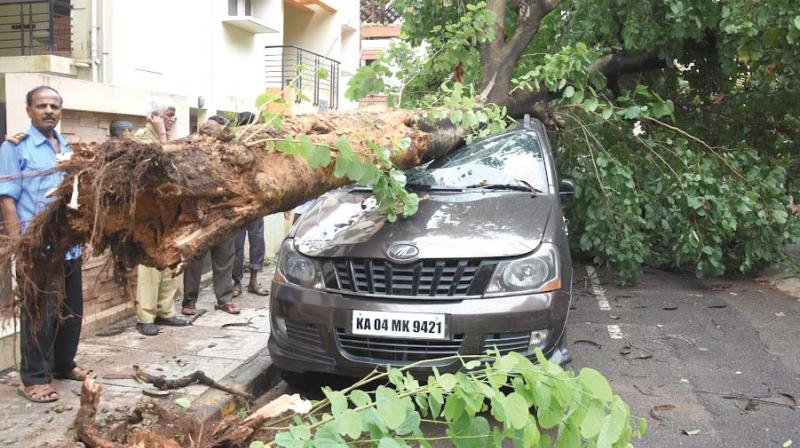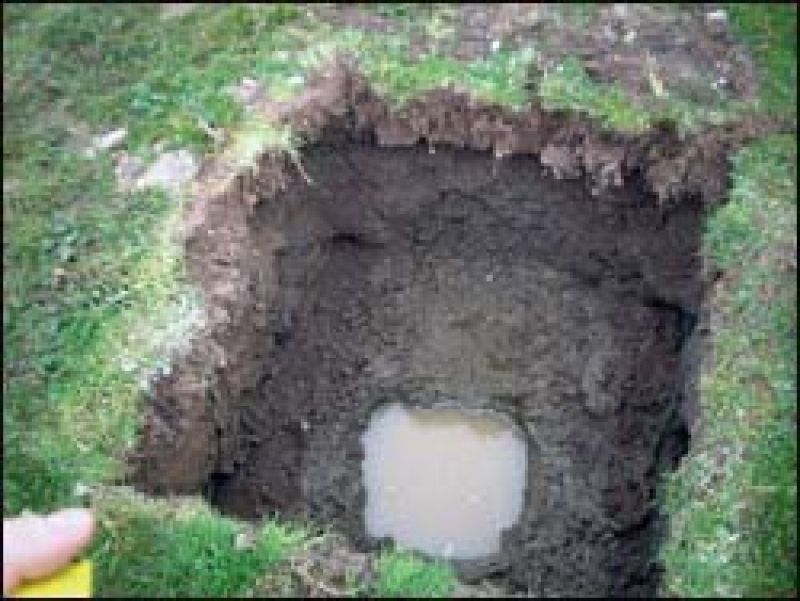Monsoon mess: Bengaluru drained out

Every year, the monsoon unleashes a plethora of miseries on Bengaluru; city-wide blackouts, fallen trees and floods make for a sordid and all-too-familiar refrain. Stormwater drains, which double as sewage outlets and also garbage dumps for apathetic residents, overflow with a single spell of rain. And despite the authorities’ annual, monsoon-related theatrics, our problems persist. At the same time, community efforts have proved successful in several instances, from rejuvenating lakes and tackling solid waste to stopping ill-conceived civic projects. Why should our monsoon woes be any different? It’s time we dropped our dependence on insouciant babus and took charge of the situation.
The monsoons have not arrived yet and the city is already a mess in the rains that have lashed it of late. While it is usual for trees to fall and pockets of city to go without electricity in rain, Saturday night’s heavy downpour wreaked more than the usual havoc as a 100 trees came crashing down and nearly half of Bengaluru was plunged into darkness with branches falling on transformers and electric poles. Homes were flooded in several areas and a labourer was feared washed away while supervising the construction of a storm water drain.
The disturbing aspect of all the chaos was that the authorities seemed once again to be taken by surprise. Ask urban experts why the BBMP seems at a loss every year to handle the rain havoc and they have their own individual take on it.
Says architect and urbanist, Naresh Narasimhan, "I think there is a poverty of imagination. When we have the technology to send a rocket to Mars, it is pathetic to see the condition of the stormwater drains in the city, particularly as it is located on the top of a hill. It’s hard to understand why the officials are struggling to find a solution to draining rain water from a city on an elevation, when it should actually be easier.”
Drawing a comparison with Singapore, which sees no flooding despite receiving rain for 300 days a year, he asks pertinently, "If Singapore can overcome such flooding why can't our silicon valley?”
In his view, rain water should percolate into the ground immediately and not be allowed to flow over long distances. “The excess water after percolation can be let into lakes," he suggests.
Mr Narasimhan also believes that sewage treatment plants should be built on a war footing across the city. “Every constituency should have an STP and the MLA concerned should be made responsible for it, " he stresses, adding that those who dump garbage into Storm Water Drains should be heavily penalised so others don’t dare do it.
Urban planner and water expert, Vishwanath admits he has no idea why the BBMP has no plan to tackle the rain mess although everyone is aware that the city records 40mm to 670mm of rain in May. "Nothing is being done despite the Karnataka State Natural Disaster Monitoring Centre and the Indian Institute of Science having listed the city’s flood prone areas," he regrets. His solution to the recurring problem is that Bengaluru should act like a sponge in rain. “Rain water should be absorbed by percolation pits like a sponge and rain water harvesting introduced widely," he suggests.
Pointing out that gated communities like Classic Orchards and Rainbow Drive on Bannerghatta Road have each over 300 recharge wells to absorb the rain water, he says the government too should build similar recharge wells across the city on its properties and motivate ordinary people to do so as well. “This way we can prevent flooding in the city,” he reasons.
What should be done immediately according to urbanists?
- Prevent dumping of garbage into storm water drains. Penalise the offenders with hefty fines.
- Prevent entry of sewage into SWDs.
- Build as many percolation pits as possible across the city to act as a sponge and absorb rain water into the ground.
- Identify old and weak trees and remove them regularly to stop them from falling in rain.
- Get people involved in problem solving. Educate them to prevent dumping of garbage into the SWD, build percolation pits and opt for RWH widely.
- Government must build percolation pits on its properties and set an example for people to follow.
 Identify old and weak trees and remove them regularly to stop them from falling in rain.
Identify old and weak trees and remove them regularly to stop them from falling in rain.
BBMP to tackle monsoon on war-footing
Following Saturday’s squall, the BBMP called for an emergency meeting of all its joint commissioners and engineers to discuss the immediate measures to be taken to avert a future crisis.
The offices and engineers were advised at the meeting chaired by Mayor G Padmavathi and BBMP Commissioner, Manjunath Prasad to identify areas where rain water gets accumulated and find a way to prevent this. Besides being told to divide the area under them and allot assistant engineers to the flood-prone localities, the zonal chief engineers were asked to prepare a list of roads allotted to the AEs and share this along with their mobile numbers and landline numbers with the public.
“Except for emergency purposes, leaves are cancelled for all top brass right from joint commissioners to engineers till the end of the rainy season,” Mr Manjunath Prasad added in a press statement.
He disclosed that 72 temporary control rooms with one vehicle, staff and equipment would be set up under the eight BBMP zones in the next three days. “The BBMP forest cell has also been asked to set up 21 teams with one vehicle, necessary staff and equipment to be put on duty in places with heavy rainfall,” he revealed.
‘Anti-encroachment drive is genuine but limited’
The BBMP, which made a huge show of demolishing encroachment on lakes and storm water drains last year, seems to have forgotten all about it now. But ask city mayor, Padmavathi, and she assures the demolition drive will be resumed. “Encroachment of storm water drains and dumping of garbage into them are mainly responsible for the mess we are seeing,” she says, adding that the SWD department has been told to act first in flood- prone areas and build concrete drains over kacha drains and all BBMP engineers have been put on high alert to handle any crisis in rain.
As for urban evangelist, V Ravichandar , he too maintains that the anti-encroachment drive, which razed the houses of many poor, was not an eyewash. "It was, however, limited, " he agrees.
Regretting that the city’s drain network has not been fully remodeled, he warns that flooding is bound to recur because of this. “As the city’s basic infrastructure is in bad shape it crumbles in heavy rain every time. The BBMP needs to beef up disaster assistance and recovery services and focus on getting things back to normal post a major downpour," he emphasises .
As for trees being uprooted in heavy rain and wind, Mr Ravichander blames the departments concerned for not addressing the problem, but only reacting to the damage caused every time.
Recalling that a decade ago a family was washed away in its car in a storm water drain in a heavy downpour, he strongly recommends building barriers along the SWD network. Also, unhappy that despite the huge amount spent on desilting drains, there is nothing to show for it, he points out glumly, “The results are not visible and it is difficult to monitor the extent of desilting actually done."

